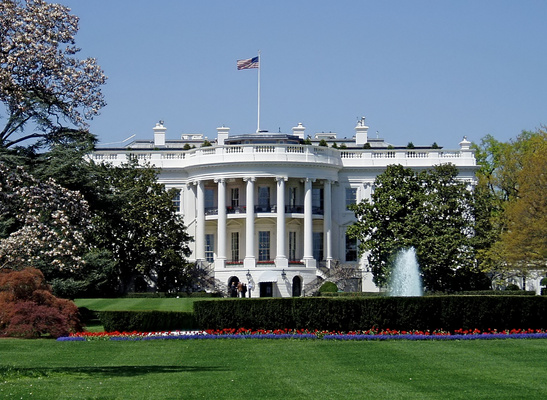
by Carolyn Gramling, with additional reporting by Megan Sever and Erin Wayman Thursday, January 5, 2012

The White House. Wikimedia Commons
The Obama administration emphasized scientific innovation and education in its fiscal year 2012 budget requests. On Monday, the president’s science advisor, John Holdren, summarized the requests across the different agencies as part of a “tough-love” strategy outlined in the president’s State of the Union speech in January to “win the future.”
While some agencies — notably those with basic research agendas, such as the National Science Foundation (NSF), the National Institute of Standards and Technology labs and the Department of Energy’s (DOE) office of science — saw large increases in their budgets relative to 2010 enacted budgets (used for comparison, as the budget for 2011 is still uncertain), others, including NASA, were less fortunate. Overall, the emphasis was on funding clean energy research and development, improving cyberinfrastructure around the nation (from smart-grid technology to providing wireless Internet to all homes) and improving education in science, technology, engineering and math (STEM).
Central to that plan is a nearly 13 percent increase in the budget for NSF to almost $7.8 billion. NSF Director Subra Suresh announced the budget Monday, saying that this increase, despite a year of belt-tightening, “reflects the confidence the president is placing in NSF.”
The NSF request puts heavy emphasis on another common theme: the concept that the U.S. is entering into a “new era of observation,” Suresh said at the budget rollout. In addition to enhanced funding for STEM education, NSF is slated to receive millions to improve cyberinfrastructure — how scientists store and share data. Recognizing the growing need for better management, storage and attribution of the reams of data collected by scientists, NSF implemented a new policy in January, requiring principle investors of prospective projects to include a data management plan with their proposals. The 2012 budget would put more than $100 million toward a cyberinfrastructure program that NSF says would help create a new framework for data sharing between scientists and agencies.
Although Suresh insisted that NSF’s mission to fund basic scientific research was still central, the budget would significantly enhance the foundation’s engineering directorate, part of an effort to not only fund new scientific discoveries but also to “capitalize” on those discoveries.
Other highlights of the NSF budget include more than $100 million toward new shared nanotechnology initiatives (in conjunction with other government agencies), such as sustainable nanomanufacture and nanoelectronics. NSF also plans to put $900 million toward clean energy research through the Science, Engineering and Education for Sustainability (SEES) program, established in 2010 as a five-year effort.
Energy research is also getting a boost at DOE; its science office will get an increase of 10.7 percent to $5.4 billion. Much of that will go to STEM education projects and to launching a STEM education committee to develop a newly skilled scientific workforce. Between DOE, NSF and the Department of Education, the administration is planning to invest about $100 million to prepare 100,000 new STEM teachers. DOE is also planning to put $550 million toward an Advanced Research Projects Agency, with the goal to develop “potentially game-changing clean energy technologies,” according to Energy Secretary Steven Chu.
NOAA’s budget is also a boost over fiscal year 2010 enacted levels, increased by almost 16 percent to $5.5 billion. One of the highlights of the budget request is the creation of the long-discussed Climate Service, a line office that the administration proposes would combine its climate monitoring, predictions and modeling projects into one office, and would also be more accessible and provide useful climate information to people, similar to the National Weather Service. The restructuring, NOAA Administrator Jane Lubchenco noted at a budget briefing Wednesday, would make the administration “more efficient.”
But not all agencies came out ahead. NASA’s budget remains nearly flat, with a budget request of $18.7 billion. The administration still intends to retire the space shuttle this year, and plans to continue to fund public-private partnerships with the commercial space industry to develop new spacecraft to go into low-Earth orbit (which includes servicing the International Space Station). Another high-profile project, the James Webb Space Telescope — which a review panel last November found would cost additional money to be completed by a scheduled launch date in 2014 — will be kept alive but on life support until fiscal year 2013. The mood at the NASA budget rollout was somber; NASA Administrator Charles Bolden emphasized “tough decisions” and the need to improve project management.
The U.S. Geological Survey’s (USGS) proposed budget for 2012 is $1.1 billion, a slight increase over the 2010 enacted budget. But while funds for certain programs — most notably for Landsat imaging satellites, ecosystem restoration, and coastal and marine spatial planning — increased, a number of USGS' most cherished programs would see their budgets cut, including minerals assessments, water quality programs and natural hazards programs.
© 2008-2021. All rights reserved. Any copying, redistribution or retransmission of any of the contents of this service without the expressed written permission of the American Geosciences Institute is expressly prohibited. Click here for all copyright requests.